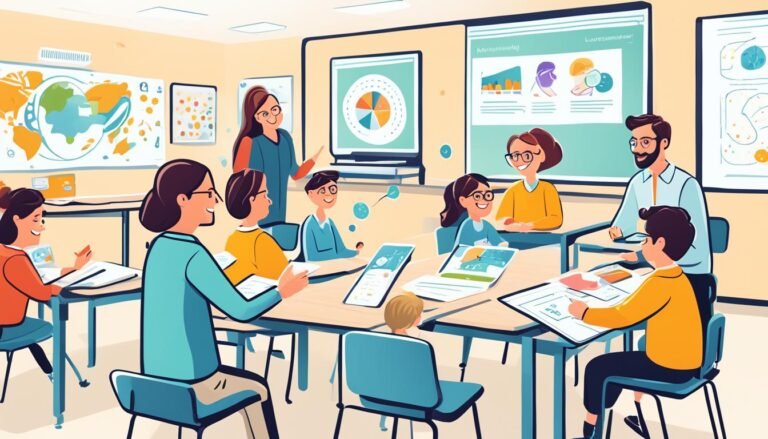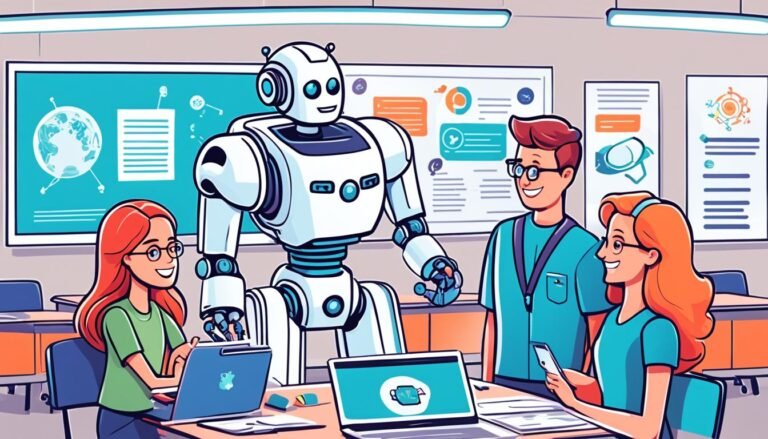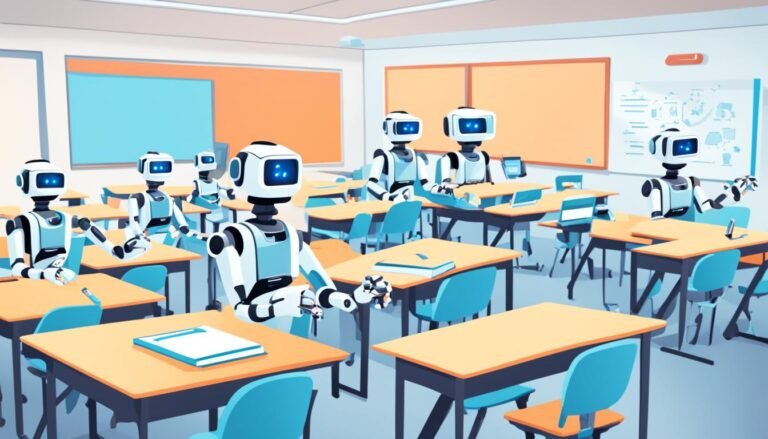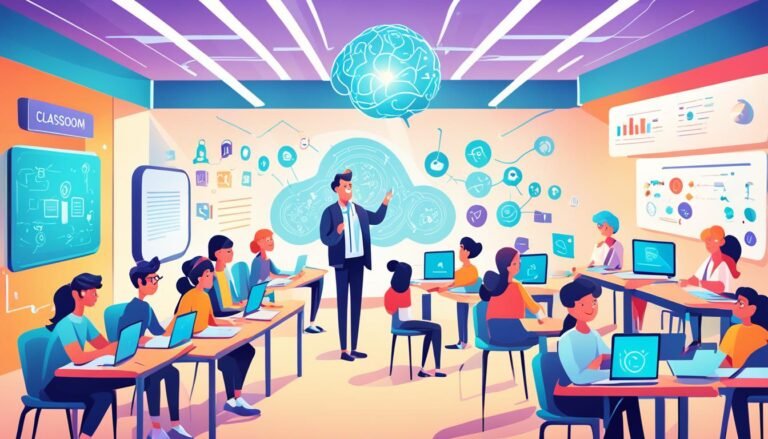AI in Classroom Teaching: Transforming Education
Imagine the mid-1970s. Teachers were worried about calculators in seventh grade. They thought math skills would suffer. Now, in 2022, calculators are key to learning. They make education more dynamic and creative.
Today, AI is the new face in the classroom. About a third of K-12 teachers use AI in teaching. Like with calculators, some are skeptical. They fear students might rely too much on technology.
But AI could change education for the better. It can offer personalized learning. This could help all students learn at their own pace. Just like how calculators helped with math, AI could transform modern education. It might make learning more fun, creative, and inclusive.
Key Takeaways
- About a third of K-12 teachers report using AI in the classroom.
- AI, like calculators, is met with skepticism but has transformative potential.
- AI promises to enhance critical thinking and humanities education.
- Personalized learning through AI could lead to more inclusive education.
- The history of calculators serves as a blueprint for adopting AI in education.
Introduction to AI in Classroom Teaching
The use of AI in Classroom Teaching is changing education significantly. OpenAI’s ChatGPT, a free AI program, was released in November. This move has interested many in using AI tools for teaching. It is causing educators to change how they teach and interact with students.
What Is AI?
AI means machines can act like they have human thinking and learning ability. It can do things like find patterns, understand human language, and solve problems. These are key for making learning more fun and personal for students.
History of Technology in Education
The use of educational technology has changed a lot over time. It started from basic blackboards to now using digital tools. Houman Harouni says education is quickly getting better because of machine learning. Just like calculators were once thought of as bad, adding AI to teaching can make things better.
Expanding the idea, AI can help in similar ways. Just as people got used to calculators and saw their value, they might also like the help AI can give. This might lead to big improvements in how we teach and learn.
Integration and Benefits
| Aspect | Previous Technology (Calculators) | Current Technology (AI) |
|---|---|---|
| Adoption Period | Gradual | Rapid |
| Initial Resistance | High | Moderate |
| Impact on Learning | Positive (Enhanced Calculation Skills) | Positive (Enhanced Critical Thinking and Creativity) |
| Educator Involvement | Minimal Initial Guidance | Active Engagement Required |
The Role of AI in Personalized Learning
AI has changed how students learn by letting teachers focus on each student’s needs. It helps by using special programs that adjust lessons based on what each student knows. This makes learning more personal and helpful for everyone.
Adaptive Learning Platforms
Adaptive learning programs use smart AI to customize what students learn to their liking. These tools pick up what students find easy or hard and change the lessons to fit. The Shiv Nadar Foundation uses these cool tools to make learning better for everyone.
This tech also helps teachers by taking care of daily tasks. This means teachers can spend more time chatting with their students or helping out. Ms. Anju Wal from Shiv Nadar School Faridabad says these tools make learning really fun and interesting.
Benefits of Personalized Learning
Personalized learning has big advantages. It gets students more into learning and they remember things better. This is because AI can tell what each student needs and helps them the right way.
| Benefits | Details |
|---|---|
| Enhanced Engagement | Personalized learning keeps students engaged by addressing their individual interests and needs. |
| Higher Retention Rates | Customized feedback and targeted teaching methods help students retain information more effectively. |
| Inclusive Education | A personalized approach ensures that diverse learning styles are accommodated, making education more inclusive. |
| Reduced Teacher Workload | AI automation of repetitive tasks allows teachers to focus on meaningful interactions rather than administrative duties. |
Places like the Shiv Nadar Foundation are working hard to use AI to teach better. By using AI and personalized learning, schools are becoming better for everyone. Learning is more fun and easier for students all around.
AI-Powered Teaching Assistants
AI-powered teaching assistants are changing classrooms for the better. They offer personal help and advice to students. These systems act like a friend, giving teachers tips instantly. They even create summaries that help teachers see what’s going on in class. This makes education better for everyone.
The AI Teaching Assistant program is getting popular among CSD Unit 3 teachers. More and more want to use AI to help in classes. AI tools are now ready for students from various grades and backgrounds. Teachers can get support through emails and guides. This helps them use the new technology well.
The TA Pounce is a star among AI teaching assistants. It helps students get better grades by 5 to 6 points. For instance, in microeconomics, more girls got A’s or B’s when using TA Pounce. Also, black students who interacted with this tool got better grades. This shows it can help make education more fair.
| Metric | Regular Class | With AI Teaching Assistant |
|---|---|---|
| Students earning B or higher | 60% | 66% |
| Female students earning A or B | 60% | 72% |
| Students likely to drop class | 9% | 3% |
Learning how to train machine learning models is fun. Sites like Code.org have many lessons and videos. These make learning exciting. There are also updates and newsletters that keep everyone in the loop about AI.
AI tools like Fobizz and Gradescope help grade students’ work. Apps like EssayGrader point out writing mistakes. They even suggest how to fix them. Then, there are tools like Quizizz and Kahoot! that turn learning into a game. This makes studying interactive and fun.
In the end, AI is making education better. With intelligent systems and tools, teachers can offer personal learning experiences. It meets the various needs of all students.
Interactive AI-Based Learning Tools
Interactive AI-based learning tools are changing how students learn. They use AI to make learning fun and valuable. This gives each student their own learning path.
Tools That Engage Students
Interactive AI tools make learning interesting. They include chatbots that let students talk about anything and AI writing helpers. These tools make learning safe and fun, boosting students’ confidence.
Examples of AI-Based Tools
Many AI tools are helping make learning better:
- Canva Magic Write: Helps with coming up with ideas, making plans, and creating cool presentations easily.
- Eduaide.AI: Gives over 100 ways to teach and translates them into 15+ languages.
- Quizizz: Lets teachers make special learning paths for students. It makes questions easier or harder with the help of AI and checks for grammar.
- Slidesgo’s AI Presentation Maker: Makes good Google Slides presentations fast.
- Nearpod: Helps make learning interesting with fun quizzes, polls, and activities that suit different students’ styles.
Look at this table to see how AI tools help teachers do better:
| Tool | Key Features | Benefits |
|---|---|---|
| Canva Magic Write | Brainstorms, plans, designs, and makes visual aids | Makes creating content faster, saves time |
| Eduaide.AI | Creates resources, translates instantly | Brings many teaching materials, better for all students |
| Quizizz | Makes special learning paths, adjusts questions with AI | Fits each student’s needs, helps them learn better |
| Slidesgo’s AI Presentation Maker | Has different presentation topics and vibes | Makes getting ready faster, improves how presentations look |
| Nearpod | Offers lessons with many media types and interactive parts | Makes lessons fun, works for different ways of learning |
Enhancing Educational Equity with AI
AI helps make education fairer by focusing on educational equity. It tackles the gaps in access to technology and personal learning. This new tech makes learning fit different ways of learning better.
Addressing Learning Differences
AI lets teachers meet each student’s needs. Tools like adaptive software check your progress as you learn. They provide help right away. This is great for students who find regular learning hard. AI plans that match personal needs help all students, especially those who need extra support.
The U.S. Department of Education sees the big need for AI in education. It points out that not all students have the same chances. They say using AI smartly could help make learning fairer for everyone.
Supporting Diverse Learning Styles
AI is also good with different ways of learning. It can adjust how it teaches each student. This is hard to do with just regular teaching. Teachers can use AI tools, like smart tutors, online tests, and virtual learning, to make lessons better for all students.
Tools like AI tutors from Khanmingo support both students and teachers. They help in new ways that were not possible before. For example, MSU Denver’s Virtual Lab Assistant lets students control lab work by voice, helping those with eyesight issues.
There is a push for better digital access and rules through the Digital Equity Framework. A webinar talked about using AI to ensure every student can learn, no matter their tech setup. It discussed practical steps for schools to overcome tech barriers.
| Key Domain | Description |
|---|---|
| Leadership for Digital Transformation | Guiding comprehensive integration of AI in classrooms. |
| Coherent Systems | Establishing structured policies and frameworks. |
| Resources and Policies | Ensuring equitable resource distribution and policy support. |
| Consistent Access | Providing reliable access to devices and connectivity. |
| Digital Competency | Promoting the digital skills necessary for AI utilization. |
| Powerful Learning Propelled by Technology | Fostering engaging and personalized learning experiences. |
In using AI, schools need to watch out for unfair situations, especially for students of color. By carefully choosing AI solutions, schools can make sure every student gets a fair shot. This makes for a better and fairer place to learn for all.
Ethical Considerations of AI in Education
AI in the classroom can change everything. But, it brings big ethical issues that need solving. We must tackle these to make sure everyone gets a fair education. We look closely at things like personal data safety, avoiding bias, and what the AI creators really want.
A recent study talked to 248 teachers from K-12 across 41 US states. This research showed that teachers at different levels have different views on AI ethics. More than half the teachers were women. They tend to like rules-based ethical approaches. But men teachers worry more about the outcomes.
The USC Center for Generative AI and Society is leading the way in ethics. They have an AI Fellows Program to boost students’ skills in thinking and writing about AI ethically. This helps undergraduates be ready for the complicated ethical questions they may face.
Also, the study pointed out important ethical challenges, such as:
- Transparency and oversight: AI systems must show us how they work. They need to be safe from misuse or harmful use.
- Diversity and fairness: AI should be fair and for everyone. It needs to fight discrimination and help all equally.
- Privacy and data governance: Keeping user data safe and using it the right way is crucial. It protects trust and student privacy.
Educational places all over the world are using AI. It’s necessary to think about ethics from the very start. This way, we make learning spaces that are fair, safe, and open to all. Everyone should benefit from the new tech equally.
Challenges in Implementing AI in Schools
AI offers many pluses for schools, but it’s not easy to use it well. There are tech problems and the need for teachers to learn. Also, there are worries about privacy and safety in schools when AI is used.
Technical Barriers
Technical issues are a big hurdle. Around 68% of educational institutions find it hard to get AI into classrooms. They may lack the tech know-how or not have the needed resources. Plus, AI tools can be expensive, causing problems for 45% of schools and universities.
Teacher Training and Adoption
Training teachers on how to use AI is a must. They need to feel well-prepared and skilled in AI to make it work. It’s also key for them to teach students ethical and critical thinking with AI. Without the right training, AI in the classroom may not do what it’s supposed to.
Privacy and Security Concerns
Keeping student data safe from AI is a big focus. 78% of teachers see it as a major concern with using AI. Following strict rules like FERPA and COPPA is crucial. Making clear policies for using AI responsibly can help protect student info. But, it’s still a major challenge to keep data safe while using AI to teach.
To tackle these issues, schools need a smart plan. Starting small and growing AI step by step works better than big changes. Ongoing teacher training and solid data safety rules are key. They help school use AI well, making learning better for everyone.
The Future of AI in Classroom Teaching
The future of AI in education looks bright. New tech is changing how we teach and learn. It’s making lessons more personal and efficient.
Emerging Technologies
Today, we see AI tools like smart learning apps and feedback systems in classrooms. By 2025, AI might do half of the work teachers do now. This will let teachers focus more on students.
AI is also bringing social robots to help with feelings and dreams. This new way of teaching makes lessons better fit how kids learn. It makes classrooms run smoother, too.
Even with all this tech, teachers are still needed. They give support and make classrooms places to grow together.
Long-Term Benefits and Predictions
AI is making a big difference by giving teachers more time to help students learn. It could give teachers up to 13 more hours each week. This extra time makes teachers happier and more effective.
AI is also making learning more personal. It provides tutors that explain things in a way each student can understand. This helps students learn in the best way for them. It means students will learn skills they need for the future job market.
In the long run, AI will help make learning better for everyone. It will make sure kids get a fair chance to learn and keep learning all their lives. But, it’s important that everyone works together to use AI in the best way. With the right teamwork, AI can make education better and fairer for all.
Conclusion
Artificial Intelligence is changing how education works. It makes learning fun and effective through personalized lessons and quick feedback. The use of AI in education will greatly increase how well students do in their studies.
AI also helps with boring tasks like grading, saving teachers time. This lets teachers focus more on helping students learn. But, it might change teaching jobs and make learning feel less personal.
AI brings both good things and challenges to education. Making sure everyone can use AI, keeping traditional teaching for important skills, and thinking about ethics are key. By using AI wisely, schools can be better places for learning that get students ready for the future.
Source Links
- AI Can Transform the Classroom Just Like the Calculator
- AI in the Classroom
- AI education and AI in education
- Embracing Artificial Intelligence in the Classroom
- EU Code Week
- Introduction to Teaching with Artificial Intelligence (AI)
- The Role of AI in Personalized Learning for Students
- The Role of AI in Education
- Perspective | An educator’s journey through personalized learning to AI integration
- AI Teaching Assistant
- An AI Teaching Assistant Boosted College Students’ Success. Could It Work for High School?
- 6 Ways to Use AI as Your Personal Teaching Assistant – BridgeUniverse – TEFL Blog, News, Tips & Resources
- 7 AI Tools That Help Teachers Work More Efficiently
- 9 AI Tools for Teachers to Create Interactive Learning Materials – Educationise
- AI in education: Use cases, solution and implementation
- How AI for Education Can Address Digital Equity – Digital Promise
- How we can use AI to increase access and equity in science education
- The Potential of Artificial Intelligence to Empower Teachers and Advance Equity | UMD College of Education
- How teachers make ethical judgments when using AI in class
- Ethical AI for Teaching and Learning
- Exploring the ethics of artificial intelligence in K-12 education – News
- Predicting the Challenges of AI Use in Schools (And How to Avoid Them)
- Incorporating Artificial Intelligence Into The Classroom: An Examination Of Benefits, Challenges, And Best Practices
- The opportunities and challenges of AI in higher education
- The Future of AI in the Classroom
- Artificial Intelligence and the Future of Teaching and Learning: What You Need to Know
- How is Classroom AI Changing Education?
- The Pros And Cons Of AI In Education And How It Will Impact Teachers In 2023 | ClassPoint
- AI in the Classroom | Greylock
- What is the Conclusion of Artificial Intelligence in Education?







